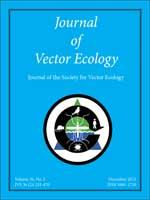Escape responses of mated and unmated nulliparous Aedes aegypti mosquitoes were compared using three different concentrations of deltamethrin in the presence or absence of a live animal host using an excito-repellency (ER) test system. Both insecticide contact (excitation) and non-contact (repellency) test configurations were compared. For contact trials, mated mosquitoes showed similar escape movements among the three concentrations when host stimuli were absent. Significant differences in responses were seen between the lower concentrations of (LC50 and LC75) deltamethrin with and without hosts present (P<0.05). Presence or absence of host stimuli produced no significant differences in escape response for unmated females when exposed to the highest concentration (LC90) of deltamethrin. Our findings indicate that as deltamethrin concentrations decrease to sublethal levels, mating status and host cues play a more significant role in escape behavior. Therefore, insemination can influence the outcome of feeding success and flight movement of nulliparous female Ae. aegypti in contact with deltamethrin and in the presence of live host stimuli. The ER assay system serves as a useful tool for observing excitation and repellency responses of Ae. aegypti to insecticides in the presence or absence of other environmental and biological cues that can affect mosquito behavior.
How to translate text using browser tools
1 December 2011
Host Feeding Responses of Aedes aegypti (L.) Exposed to Deltamethrin
Wasana Boonyuan,
Monthathip Kongmee,
Michael J. Bangs,
Atachariya Prabaripai,
Theeraphap Chareonviriyaphap
ACCESS THE FULL ARTICLE
It is not available for individual sale.
This article is only available to subscribers.
It is not available for individual sale.
It is not available for individual sale.

Journal of Vector Ecology
Vol. 36 • No. 2
December 2011
Vol. 36 • No. 2
December 2011
Aedes aegypti
deltamethrin
excitation
feeding responses
host stimuli
repellency




